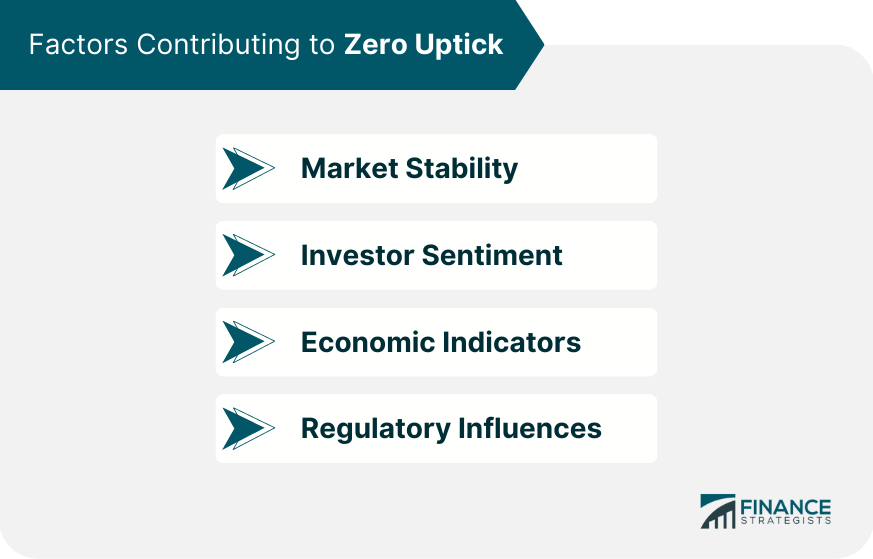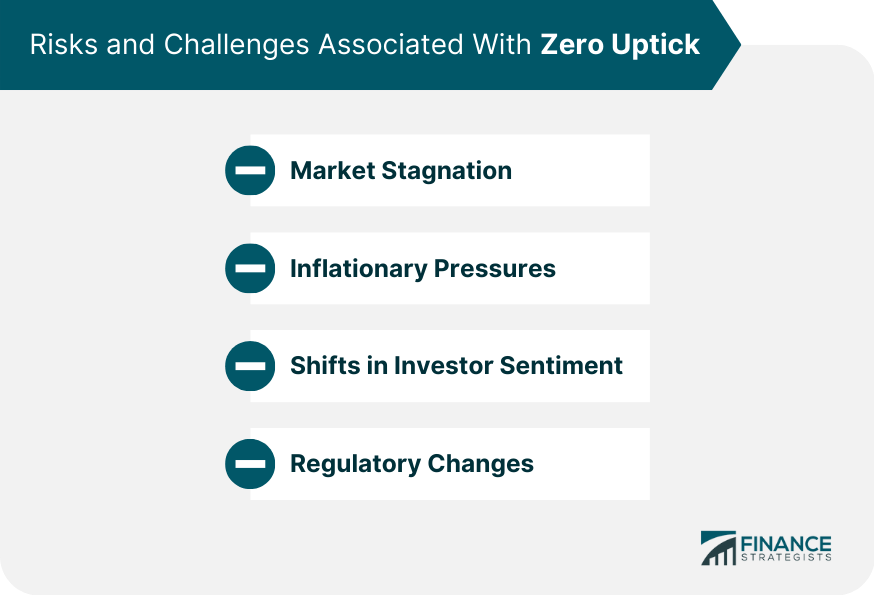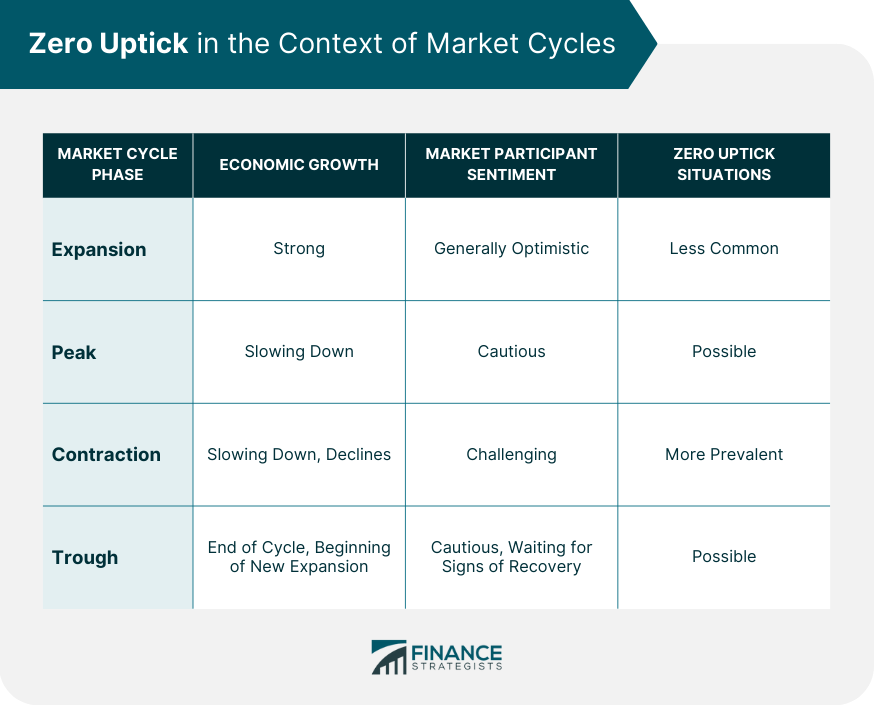Zero uptick refers to a situation in financial markets where the price of a financial instrument, such as a stock, bond, or commodity, does not experience any increase in value over a given period. This can be the result of various factors, including market stability, investor sentiment, economic indicators, and regulatory influences. The term "uptick" has been used in financial markets since the early days of stock trading, and it refers to an increase in the price of a security. The concept of zero uptick emerged as investors and analysts began to study market trends and fluctuations more closely, noticing periods when certain securities or markets would remain relatively stable without significant price changes. One of the primary reasons for a zero uptick situation is market stability. When the overall market is stable, individual financial instruments may not experience significant price changes, resulting in zero uptick. Investor sentiment plays a significant role in determining the direction of market movements. A lack of positive sentiment can lead to a period of zero uptick, as investors may be hesitant to buy or sell securities due to uncertainty or unfavorable market conditions. Various economic indicators, such as GDP growth, unemployment rates, and inflation, can influence the movement of financial markets. If the economy is stable and economic indicators are relatively flat, zero uptick situations can occur. Changes in financial regulations or government policies can impact the performance of financial instruments. In some cases, these changes can lead to periods of zero uptick, as market participants adjust to new rules or policies. Blue-chip stocks, typically associated with large, well-established companies, can experience zero uptick during periods of market stability or uncertainty. Due to their size and stability, these stocks may be less volatile than other stocks and may not experience significant price fluctuations. Small-cap stocks, representing smaller companies with lower market capitalization, can also experience zero uptick. While small-cap stocks are generally more volatile than blue-chip stocks, certain factors, such as market stability or lack of investor interest, can contribute to periods of zero uptick. Government bonds, which are debt securities issued by a government to finance public projects or fund government operations, can experience zero uptick in periods of low interest rates or stable economic conditions. Corporate bonds, issued by companies to raise capital, can also experience zero uptick. This can occur when the issuing company is stable, and there is no significant news or events impacting its financial performance. Precious metals, such as gold and silver, can experience zero uptick during periods of market stability or when investors have a reduced appetite for risk. Energy resources, including oil and natural gas, can also experience zero uptick due to factors such as stable supply and demand or regulatory changes. A buy-and-hold strategy involves purchasing a financial instrument and holding it for an extended period, regardless of market fluctuations. This approach can be effective during periods of zero uptick, as investors can potentially benefit from long-term growth and avoid short-term market volatility. Dollar-cost averaging is a strategy where an investor consistently invests a fixed amount of money in a financial instrument at regular intervals. This approach can be beneficial during zero uptick periods, as it allows investors to take advantage of market fluctuations and potentially lower their average cost per share. Market timing involves attempting to predict the future direction of market movements and making investment decisions accordingly. Although challenging to execute successfully, this approach can potentially generate profits during periods of zero uptick by identifying and capitalizing on short-term market trends. Technical analysis is a method of evaluating financial instruments by analyzing historical price and volume data to identify patterns and trends. This approach can be useful during zero uptick periods, as it can help investors identify potential entry and exit points based on historical price movements. Fundamental analysis involves evaluating a financial instrument based on its underlying financial health, such as revenue, earnings, and debt levels. By conducting a thorough fundamental analysis, investors can identify undervalued securities during periods of zero uptick and potentially capitalize on their future growth. One of the primary risks associated with zero uptick is market stagnation. Prolonged periods of zero uptick can lead to stagnant markets, with limited opportunities for growth and profit. Inflation can erode the purchasing power of investments, especially during periods of zero uptick. Investors must consider the impact of inflation on their investments and adjust their strategies accordingly to preserve their capital. Investor sentiment can change rapidly, leading to sudden market movements. During periods of zero uptick, investors should monitor market sentiment closely and be prepared to adjust their investment strategies as needed. Changes in financial regulations or government policies can have significant impacts on financial instruments. Investors should stay informed about potential regulatory changes and adjust their investment strategies accordingly. During the expansion phase of a market cycle, economic growth is strong, and market participants are generally optimistic. Zero uptick situations may be less common during this phase, as financial instruments are more likely to experience price increases. The peak phase represents the height of a market cycle, where economic growth begins to slow, and market participants may become more cautious. Zero uptick situations can occur during this phase, as investors may be hesitant to buy or sell securities due to uncertainty about the market's future direction. During the contraction phase, economic growth slows, and markets may experience declines. Zero uptick situations can become more prevalent during this phase, as financial instruments may struggle to gain value amid challenging market conditions. The trough phase marks the end of a market cycle and the beginning of a new expansion phase. Zero uptick situations can still occur during this phase, as investors may be cautious about entering the market until signs of a recovery become more evident. Zero uptick is a critical concept for investors and financial professionals to understand, as it provides valuable insights into market trends, potential risks, and opportunities for profit. Recognizing the factors contributing to zero uptick, such as market stability, investor sentiment, economic indicators, and regulatory influences, is essential for making informed investment decisions. Adapting to zero uptick situations in various financial instruments, such as stocks, bonds, and commodities, can help investors develop effective investment strategies and mitigate risks. Furthermore, understanding zero uptick in the context of market cycles and historical events can provide valuable lessons for navigating future market fluctuations. The ability to recognize and adapt to zero uptick situations benefits not only individual investors but also the financial markets as a whole. By staying informed about market trends, economic indicators, and regulatory changes, market participants can contribute to overall market stability and make well-informed decisions. As financial markets continue to evolve, understanding the causes and implications of zero uptick will remain an essential skill for investors and financial professionals alike. By leveraging the knowledge of zero uptick, market participants can better navigate the complexities of various market situations and capitalize on potential opportunities for growth and profit.What Is Zero Uptick?
Factors Contributing to Zero Uptick
Market Stability
Investor Sentiment
Economic Indicators
Regulatory Influences

Zero Uptick in Different Financial Instruments
Stocks
Blue-Chip Stocks
Small-Cap Stocks
Bonds
Government Bonds
Corporate Bonds
Commodities
Precious Metals
Energy Resources
Strategies to Capitalize on Zero Uptick
Passive Investment Approaches
Buy-And-Hold Strategy
Dollar-Cost Averaging
Active Investment Approaches
Market Timing
Technical Analysis
Fundamental Analysis
Risks and Challenges Associated With Zero Uptick
Market Stagnation
Inflationary Pressures
Shifts in Investor Sentiment
Regulatory Changes

Zero Uptick in the Context of Market Cycles
Expansion Phase
Peak Phase
Contraction Phase
Trough Phase

Final Thoughts
Zero Uptick FAQs
A zero uptick is a situation where the current price of a security is the same as its previous price, with no increase in value.
In short selling, the Securities and Exchange Commission (SEC) has a zero uptick rule that restricts traders from shorting a stock unless the stock has just ticked higher in price. This rule prevents traders from pushing the stock price down further by shorting after the stock price has already fallen.
The opposite of a zero uptick is a zero downtick, which occurs when the current price of a security is the same as its previous price, with no decrease in value.
A zero uptick is significant because it can prevent short selling of a security. If a security has experienced a price decline, the zero uptick rule prohibits traders from short selling that security unless the last trade resulted in a positive price change.
A zero uptick is a situation where the last sale price of a security is the same as its previous sale price, while a plus tick is a situation where the last sale price of a security is higher than its previous sale price.
True Tamplin is a published author, public speaker, CEO of UpDigital, and founder of Finance Strategists.
True is a Certified Educator in Personal Finance (CEPF®), author of The Handy Financial Ratios Guide, a member of the Society for Advancing Business Editing and Writing, contributes to his financial education site, Finance Strategists, and has spoken to various financial communities such as the CFA Institute, as well as university students like his Alma mater, Biola University, where he received a bachelor of science in business and data analytics.
To learn more about True, visit his personal website or view his author profiles on Amazon, Nasdaq and Forbes.















